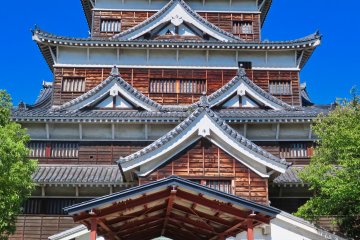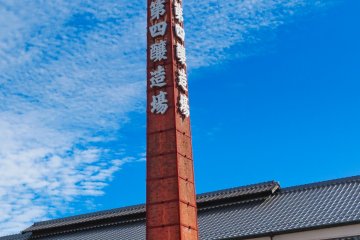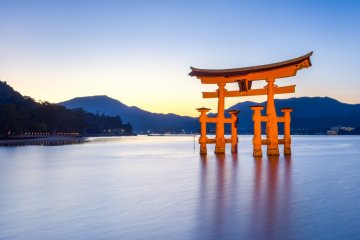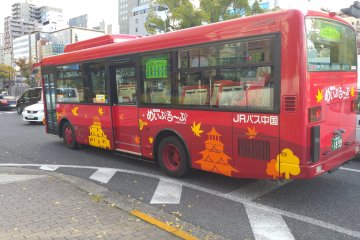The Golden Route describes a conventional way to see Japan for first-time visitors, taking in some of its established cities—like Tokyo and Kyoto—as well as chasing a view of Mt Fuji too. But for those travellers visiting Japan for the second time, or looking to get off the beaten path, it is the west of Japan that holds the most potential hidden gems.
The “Golden Route to West Japan” invites you to explore a lesser-known side of the country—one that is well connected, filled with exciting destinations to discover, and rich in its own distinct cultural and historical heritage.
West Japan spans two of the country’s main islands, Kyushu and Shikoku, as well as a vast stretch of its largest, Honshu. Within this region lies a remarkable variety of destinations: from the UNESCO World Heritage Site of Himeji Castle to the art islands of the Seto Inland Sea, the circular pilgrimage of Shikoku’s 88 sacred temples, and the coastal sand baths of Beppu’s hot springs, West Japan will not disappoint.
Today, we take a journey west from Osaka to explore two major stops along this route, Hiroshima and Fukuoka.
Hiroshima
Known worldwide as the site of the first atomic bombing on 6 August 1945, modern-day Hiroshima has since blossomed into a vibrant metropolis, transforming into a remarkable destination in its own right. This ‘City of Water,’ built between on a delta of six rivers, hums with the energy of its homegrown culture—from the countless Hiroshima-style okonomiyaki shops and the trundling streetcars that crisscross the city, to the passionate fans of the red Hiroshima Carp baseball team and the purple Sanfrecce football club.
Hiroshima exudes a pride and character unlike anywhere else in Japan, and is just 1hr 30min by shinkansen from Shin-Osaka Station. Let’s take a closer look at some sights we recommend adding to any Hiroshima trip.
Peace Memorial Park

Located between the Motoyasu and Honkawa rivers, Peace Memorial Park is home to the Hiroshima Peace Memorial Museum. Fully renovated in 2019, the updated exhibits powerfully convey stories of victims through the lens of the survivors, using their written memories and artifacts left behind. As well as helping visitors truly understand the city’s sombre past, these narratives leave a powerful impression on the mind as you come to realise the profound impact of the bombing’s aftermath.

Along with the surrounding Peace Memorial Park, the museum is one of many initiatives by Hiroshima City in pursuit of everlasting world peace and the abolition of nuclear weapons. The park itself is home to several monuments that commemorate victims of the atomic bombing. The Children's Peace Monument commemorates the thousands of children who were victims of the bombing, including Sadako Sasaki, who survived the bombing only to succumb to leukemia at the age of twelve. The Cenotaph for the Atomic Bomb Victims, which is home to a registry of the names of over 300,000 people who lost their lives, can be found adjacent to the Flame of Peace. From beneath the Cenotaph’s arch, a powerful view is revealed of both the flame and the distant A-Bomb Dome. One of the few surviving structures from the blast, today the dome serves as a powerful symbol of the city’s resilience in the aftermath of 1945 and a reminder of a past we must never forget.

Access: The park’s closest stop is Genbaku Dome-Mae Station (Hiroden tram lines 2, 3, 6 and 7).
Miyajima

The enchanting, sacred island of Miyajima can be found an hour southwest of Hiroshima City and is easily reached by train or tram. A UNESCO World Cultural Heritage, Miyajima is well known for its iconic, red vermilion torii gate which proudly stands overlooking the island’s Itsukushima Shrine. At high tide, it even appears to float on the water, creating a defining spectacle that is deservedly considered one of Japan’s top 3 views. The shrine’s main buildings rise on stilts across a small inlet, reflecting historical beliefs that the island itself is sacred and could not be directly constructed on. This “Island of Gods” is where kami were worshipped and enshrined, also explaining why 80% of the island is still covered by protected national forest.

Walking along the shrine’s pathways is a unique experience, especially at high tide, when the support structures are submerged and the buildings appear to float on the water. The shrine itself is reached in about a 10-minute walk from the island’s port, taking you past the charming Omotesando Shopping Street, which bustles with vendors selling everything from grilled oysters (a local delicacy) to maple leaf-shaped momiji manju cakes, or local Miyajima craft beer.

Take a break here, freely stroll along the coastal path while admiring the resident island deer, or seek out the nearby ropeway station to take you up to near the summit of Mt. Misen. Miyajima offers plenty of things to see and do. While many visitors plan a day trip—the last ferry departs around 10pm—it’s equally rewarding to slow down and stay overnight at one of the island’s charming ryokan.
Access: To reach the ferry terminal, take a tram from central Hiroshima bound for Hiroden Miyajima-guchi (route 2). The journey takes about one hour. If you’re near Hiroshima Station, it can be faster to take a JR Sanyo Line train down south, alighting at Miyajimaguchi Station, after a 27-minute journey. From here, it’s a short walk to the ferry terminal.
Simose Art Museum

Opened in 2023, the Simose Art Museum is an architectural gem that perches on the coast overlooking Hiroshima Bay and several islands of the Seto Inland Sea. The contemporary structure is designed by renowned architect Shigeru Ban and picked up an award at the 2024 Prix Versailles in recognition of its beauty. From the rising tree-like timber arches that grace the entrance hall to the tall panels of glass that reflect the surrounding nature, the immersive museum is a delight to explore before you even reach the actual exhibitions—which is where it gets exciting! The main works here are arranged inside eight movable galleries that appear to almost float above a basin of water. These colorful cubes are inspired by the islands across the Inland Sea and are configured according to the needs of each exhibition. From outside, the reflection of the movable galleries creates a powerful contrast with the surrounding nature, which is further enhanced when they light up as twilight descends.

Access: Simose Art Museum can be reached by taking a JR Sanyo Line train to Kuba Station or Otake Station, which are further along the coastline south of Miyajima. From Otake Station, a free shuttle bus (10-min ride) runs to the museum, but check the website for its schedule. You can also take the local Koikoi Bus from either station and alight at Youme Town Otake, from where it’s a 5-minute walk.
Food Culture
Hiroshima is home to a distinctive food scene, and chief among the region’s much-loved dishes is Hiroshima-style okonomiyaki. This is a savory layered pancake of cabbage, bean sprouts, noodles, meat, and egg, finished with okonomi sauce and Japanese mayonnaise. Each layer brings its own texture and flavor, all unified by the rich, locally born Otafuku okonomi sauce.. You’ll find okonomiyaki shops throughout the prefecture, including well-known chains like Mitchan. For those heading to Miyajima, Chinchikurin inside etto at Miyajimaguchi port is a convenient favorite, offering English menus and sweeping views of the bay.

Oysters are a must-try in Hiroshima, as the prefecture produces around 60% of Japan’s supply. They can be enjoyed in countless ways—from simply grilled with a squeeze of lemon, to layered atop a hearty okonomiyaki, or breaded, fried, and served with curry. Along Miyajima’s main street, vendors like Kakifukumaru grill oysters streetside, their smoky aroma drawing in passersby. The shop also provides an English-friendly menu, making it easy for visitors to sample these local delicacies and savor the flavors of the region.

For another take on fresh, local ingredients, try Shimalabo in the Hatchbori area of downtown. This cosy 12th-floor bistro restaurant (with views of Hiroshima Castle) is run by French-trained Chef Shimamura, who takes local regional ingredients—like Miyoshi beef (Hiroshima), Shodoshima pork (Kagawa) or Okuizumo wines (Shimane)—and crafts nature-inspired French cuisine matched to the season.

Access: For Chichikurin and Kakifukumaru, see Miyajima section. For Shimalabo, it’s a 10-minute walk north of Hatchobori Station.
Fukuoka
Just an hour west of Hiroshima by shinkansen, you can reach Fukuoka, known as the gateway to Kyushu. Traditional streets, historic architecture, and centuries-old customs coexist with bustling shopping districts, lively nightlife, and contemporary city life. The city is renowned for its dynamic culinary scene, from casual street food to refined dining experiences, offering flavors that reflect both local tradition and innovation. Visitors can also immerse themselves in hands-on cultural experiences and enjoy serene spots that showcase the city’s artistry and craftsmanship. With its blend of history, culture, cuisine, and modernity, Fukuoka offers a journey full of discovery.
Yatai Food Culture & More Culinary Experiences

Fukuoka’s yatai food stalls are an iconic symbol of the city and can be seen any night of the week in downtown Fukuoka City. Clustered around the Tenjin and Nakasu districts, yatai food stalls typically seat up to ten people. During busy hours, you may find yourself shoulder-to-shoulder with strangers, sharing drinks and skewers while striking up new friendships. Sharing the experience with locals—and often fellow visitors to Fukuoka—makes yatai dining a uniquely social experience in Japan, and very much part of its charm. Some vendors, like Kuro-chan in the Nakasu area, are welcoming to foreign visitors and provide English menus too. Food will typically include staples like Hakata-style ramen and freshly grilled yakitori (chicken skewers)—with a range of alcoholic drinks available too—but with so many operating, feel free to ‘yatai-hop’ until you find the right one for you.
For another unique experience, visit Yorozu, a specialty shop dedicated to Japanese tea tranquil tea tucked away in a quiet street of Fukuoka’s Akasaka area. Inside, the serene interior invites calm reflection, where tea, cocktails (using tea), and traditional wagashi confections are served with care. Yorozu elevates tea appreciation—from matcha to sencha and beyond—into an art form, with staff preparing each brew at the copper hearth with monastic-like focus. Guests can lose themselves in the minimalist, meditative space, punctuated by soft, occasional piano notes in the background, before savoring tea served at three different temperatures and each paired with a handmade confection. The modern yet understated design reflects the vision of tea master and owner Suguru Tokubuchi, who seeks to inspire new appreciation for Japanese tea.

Established in 1963, Kappo Yoshida is a celebrated Fukuoka restaurant known for its refined kappo-style Japanese cuisine using seasonal ingredients and local Fukuoka seafood. Its signature dish, Tai Chazuke, features tender sea bream sashimi with goma (sesame) sauce, which can be served over rice, then topped with green tea to highlight the delicate flavors. The menu also offers seasonal specialities such as live squid sashimi and tempura, providing a full taste of Japanese culinary artistry. With meticulous preparation and presentation, Kappo Yoshida delivers an authentic and memorable dining experience in Fukuoka.

Access:
- Kuro-chan is a 4-min walk from Nakasukawabata Station (Exit 3, Airport Line, Hakozaki Line)
- Yorozu is a 14-min walk from Sakurazaka Station (Nanakuma Line)
- Kappo Yoshida’s Hakata Tenyamachi branch is a 3-min walk from Gofukumachi station (Hakozaki Line).
Hakata Old Town & Customs

Stepping into Hakata Old Town is like walking through a living museum. This area prospered as the hub of Hakata, when it was the largest trade port city in Japan during its Middle Ages. Narrow streets lead to Kushida Shrine, the Hakata Machiya Folk Museum, and the Hakata Sennen-mon Gate, each offering a glimpse into centuries of local history, craftsmanship, and tradition. This historic heart of Fukuoka blends the charm of old Japan with the energy of a modern city, inviting visitors to linger and explore at a leisurely pace.
Kushida Shrine is the oldest shrine in the city and is known as the guardian shrine for Hakata. Each July, it heralds the start of summer with the Hakata Gion Yamakasa Festival, which boasts over 780 years of history. Over the road, the Hakata Machiya Folk Museum offers a fascinating glimpse into Hakata’s past. Experience the traditional townhouse area, or view the exhibitions to learn about local Hakata culture, before browsing some of its crafts, like Hakata-ori textiles, the Hakata Doll or Hakata Magemono—a local, celebrated woodworking art.

Hakata Magemono is a traditional Fukuoka craft involving the bending of thin cedar or cypress strips, which are then fastened together with cherry bark. This technique has been practised for centuries and is renowned for producing durable, moisture-regulating containers, such as bento boxes. Visitors can experience this craft firsthand by participating in a private workshop led by artisan Tamaki Shibata–the 18th generation and the first female artisan to head her family legacy—who also offers demonstrations at the Hakatamachiya Folk Museum on Thursdays. These sessions provide insight into the history and techniques of Hakata Magemono, allowing participants to create their own handcrafted items.

Access:
- Kushida Shrine is a few minutes walk from Kushida Shrine Station (Nakakuma Line)
- Hakata Machiya Hometown Museum is a couple of blocks north-east of Kushida Shrine
- Shibata-san’s workshop/showroom is a 3-min walk west of Hakozaki Station (Kagoshima Line).
The Gate Hotel Fukuoka: A Modern Hub in the Heart of Tenjin

Fukuoka’s contemporary side is just as compelling. The Gate Hotel Fukuoka by Hulic, which opened in April 2025, offers a stylish base with sweeping city views, elegant interiors, and easy access to the vibrant Tenjin district. The hotel features 171 modern rooms equipped with flat-screen TVs, Nespresso machines, air purifiers, and well-appointed bathrooms with separate showers and bathtubs. Guests can unwind at the 18th and 19th-floor lounge with panoramic city views, enjoy the on-site restaurant and bar, or maintain their routine at the fitness center. Notably, the hotel’s main lobby incorporates a design inspired by Fukuoka’s rivers, symbolizing the flow of the city’s history and culture, creating a serene and welcoming first impression. Whether visiting for a night or using it as a hub for further Fukuoka City exploration, the hotel reflects Fukuoka’s modern spirit while providing comfort and convenience.
Discovering West Japan
If Osaka’s Expo 2025 has sparked your curiosity, consider planning your next Japan adventure around the diverse experiences that West Japan offers. From Hiroshima’s resilient history and vibrant culture to Fukuoka’s culinary delights, artisanal crafts, and historic streets, this region is full of discoveries off the typical tourist path.
Getting around is straightforward: aside from Shikoku, West Japan is well connected by the Sanyo and Kyushu Shinkansen, with through services like the Mizuho and Sakura trains often requiring no transfers. From Fukuoka, Kumamoto is just a 40-min train journey, with Kagoshima another hour. The region of Shikoku itself can be reached by ferry on the Oita side of Kyushu, while adventure travellers can opt to cycle across the 70-km Shimanami Kaido route spanning bridges and small islands from Onomichi. Furthermore, railway enthusiasts can take the Seto-Ohashi Line train from Okayama that crosses bridges and islands before reaching Kagawa Prefecture, meaning no two journeys to West Japan have to be the same.
With its rich heritage, modern cities, and hidden gems waiting to be explored, West Japan is emerging as a must-visit destination for travelers seeking depth, variety, and authentic experiences. Let this be the start of your next Japan journey. Learn more about Hiroshima and Fukuoka on our site, or visit the official website for the Golden Route to West Japan (including Hiroshima and Fukuoka)
































































